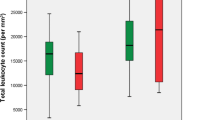Abstract
Objective
To identify the clinical variables that differentiate MRSA (Methicillin-resistant Staphylococcus aureus) from MSSA (Methicillin-sensitive S. aureus) infection.
Methods
Cases having culture isolates of Staphylococcus species were recruited. Baseline and other laboratory parameters were compared between MSSA and MRSA sub-groups to identify the predictors for MRSA.
Results
Out of 98 isolates of S.aureus, 46 (47%) were MRSA. Significant leukocytosis was found in cases with MRSA (P <0.03). None of the other clinical variables could differentiate MRSA from MSSA infection.
Conclusion
Presence of leukocytosis was twice more likely to predict MRSA than MSSA at admission. Empiric therapy must be guided by antimicrobial sensitivity pattern of regional culture isolates.
Similar content being viewed by others
References
Cosgrove SE, Fowler VG Jr. Management of methicillinresistant Staphylococcus aureus bacteremia. Clin Infect Dis. 2008;46:S386–93.
Boucher HW, Corey GR. Epidemiology of methicillinresistant Staphylococcus aureus. Clin Infect Dis. 2008;46:S344–9.
Stryjewski ME, Chambers HF. Skin and soft-tissue infections caused by community-acquired methicillinresistant Staphylococcus aureus. Clin Infect Dis. 2008;46:S368–77.
Clinical and Laboratory Standards Institute. 2013. Performance standards for Antimicrobial susceptibility testing; twenty third Informational supplement. M100-S23. Accessed September 24, 2014.
Centers for Disease Control and Prevention. 2011. Active Bacterial Core Surveillance Report, Emerging Infections Program Network, Methicillin-Resistant Staphylococcus aureus, 2011. Available from: http://www.cdc.gov/abcs/reportsfindings/survreports/mrsa11. Accessed September 23, 2014.
Lerner Norma B. The anaemia. In: Kliegman RM, Stanton BF, St.Geme JW, Schor NF, Behrman RE. Nelson Textbook of Pediatrics. 19th ed. Philadelphia,: Elsevier; 2011.p.1648.
Goldstein B, Giroir B, Randolph A, International Consensus Conference on Pediatric Sepsis. International pediatric sepsis consensus conference: definitions for sepsis and organ dysfunction in pediatrics. Pediatr Crit Care Med. 2005;6:2–8.
Dellinger RP, Levy MM, Rhodes A, Annane D, Gerlach H, Opal SM, et al. Surviving Sepsis Campaign: international guidelines for management of severe sepsis and septic shock, 2012. Intensive Care Med. 2013;39:165–228.
Joshi S, Ray P, Manchanda V, Bajaj J, Chitinis DS, Gautam V, et al. Methicillin resistant Staphylococcus aureus (MRSA) in India: Prevalence and susceptibility pattern. Indian J Med Res. 2013;137:363–9.
Golding GR, Levett PN, McDonald RR, Irvine J, Nsungu M, Woods S, et al. A comparison of risk factors associated with community-associated methicillin-resistant and- susceptible Staphylococcus aureus infections in remote communities. Epidemiol Infect. 2010;138:730–7.
Miller LG, Perdreau-Remington F, Bayer AS, Diep B, Tan N, Bharadwa K, et al. Clinical and epidemiologic characteristics cannot distinguish community-associated methicillin-resistant Staphylococcus aureus infection from methicillin-susceptible S. aureus infection: a prospective investigation. Clin Infect Dis. 2007;44:471–82.
Kini AR, Shetty V, Kumar AM, Shetty SM, Shetty A. Community-associated, methicillin-susceptible, and methicillin-resistant Staphylococcus aureus bone and joint infections in children: experience from India. J Pediatr Orthop Part B. 2013;22:158–66.
Ju KL, Zurakowski D, Kocher MS. Differentiating between methicillin-resistant and methicillin-sensitive Staphylococcus aureus osteomyelitis in children: an evidence-based clinical prediction algorithm. J Bone Joint Surg Am. 2011;93:1693–701.
Author information
Authors and Affiliations
Corresponding author
Rights and permissions
About this article
Cite this article
Senthilkumar, K., Biswal, N. & Sistla, S. Risk factors associated with Methicillin-resistant Staphylococcus aureus infection in children. Indian Pediatr 52, 31–33 (2015). https://doi.org/10.1007/s13312-015-0562-9
Received:
Revised:
Accepted:
Published:
Issue Date:
DOI: https://doi.org/10.1007/s13312-015-0562-9




